I feel this might well be a ranty post as doing the research for this infuriated me and I'm hoping I will leave you well ticked off as well. It is about a young woman called Dolly who died at the hands of the artist who painted her, but it is also about how we write about women. As always, it's also about Fanny Cornforth, because everything I write is about Fanny in the end. It all started when I looked again at some pictures of witches for an article I was writing for Enchanted Living. I was reminded how much I loved this striking image...
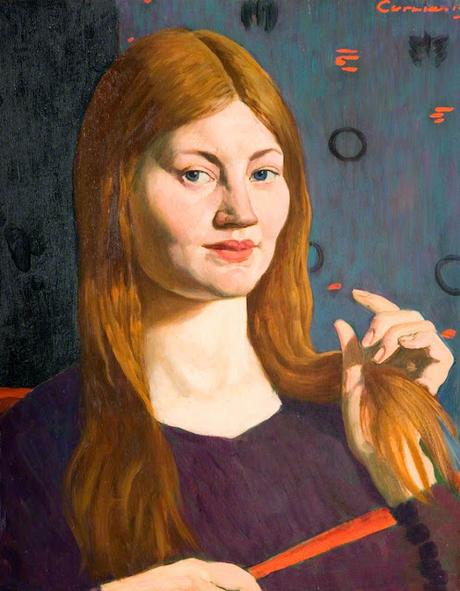
The Witch (1913) John Currie
I liked this image because it was a bit of a change from pointy hats and broomsticks, and plays into one of my favorite subjects, the banality of evil. Really evil people never look particularly evil or else they wouldn't be able to do what they do. You'd see them coming a mile off if they were all flashing cloaks and twizzling moustaches. Anyway, who says the witch has to be evil? There was just something about John Currie's witch that was slightly unsettling, that let you know she had all the power and she knew it. Mr Currie is a bit out of my normal realms of interest, although I don't mind a bit of Gertler and Carrington, so I didn't know the story behind this image. I do now and I'm hacked off. Not only that but I'm tagging Fanny in to back me up. Let's start with the witch above, because this is her story.
Dorothy Eileen Henry was born in the Autumn of 1893. Her parents, Thomas and Kate had met in Colchester, after Henry had come over from Ireland and married when Kate was barely 15. Around a dozen children swiftly followed, with Dorothy somewhere in the middle, making the Henry household somewhat packed. Thomas worked as a traveling salesman, so the family started by living with Kate's widowed mother before moving out on their own. Not all the children survived childhood but on the whole, an impressive number of the Henry children lived until the latter end of the 20th century. By 1901, Thomas and Kate and 9 of their children lived at 20 Kendall Road, Colchester, a mid-terrace house that must have been a squeeze. Kate continued having children until 1907, so it's unsurprising that the older children made their way into the world as soon as possible. Eldest daughter Katie got married, as did next oldest John. Dorothy's brother Thomas, named after his father, only made it to his 12th birthday before he died. Dorothy decided she wanted to see a bit of life and so she took herself off to London.
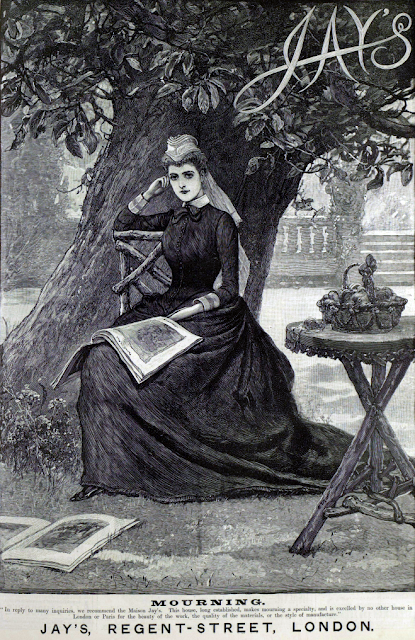
When in London, Dorothy became 'Dolly' and found work both in domestic service, then as a dress model at Jay's on Regent Street. Jay's had started out as a Mourning Warehouse, a place to get everything you needed for that full Victorian experience of death. This particularly wonderful page on it describes it as 'the Argos of grief'. It became so ubiquitous that by the turn of the century it was known simply as Jay's, rather than it's full title of 'The London General Mourning Warehouse' (magnificent) and by the look of the adverts it wasn't selling itself solely on the mourning, unlike early ads like the one above. Even a very pleasant summer tea-gown in apple green was covered in black net in 1900, so maybe those habits died hard, if you excuse the expression. Anyway, Dolly had found work as a dress model by the summer of 1911. She had flame red hair and a beautiful face and I'm sure she looked smashing in black. She met artist John Currie who was immediately attracted to her and asked her to model. She agreed and he produced a portrait of her, Head of a Girl. She was 17 years old.
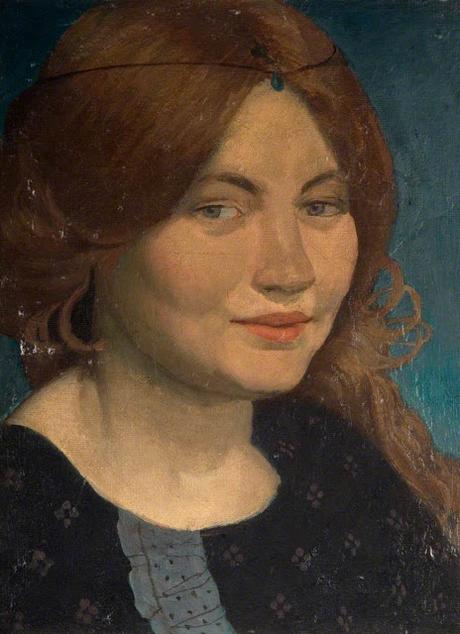
Head of a Girl (Dorothy Henry) (c.1911-14) John Currie
John Currie was 27 and married. Originally from Staffordshire where he had painted ceramics at the potteries, he had studied at the Royal Academy from 1904 to 1906, before becoming a teacher of art in Bristol for 18 months, then an Inspector under the Department of Agriculture and Technical Instruction in Ireland until 1909. Interestingly, both John and Dolly are referred to as 'Irish' in various accounts of their lives, despite neither actually being from Ireland. I wonder if it is a handy slur to explain the violence of their relationship. After that, he decided that he needed to return to college and took himself to London and the Slade, studying part time with Mark Gertler and Augustus John. He still had to work to afford it, and he is listed in the 1911 census as an 'Art Instructor', living on his own in Hampstead.
John had married Jessie Brandon, a Grocer's daughter from Staffordshire in 1907, their son Mark appearing in 1908, but Jessie did not follow John to London or if she did, she had returned home by 1911 when he met Dolly. The timeline of their affair is a little uncertain, but according to later accounts, Jessie Currie asked her husband to stop his affair with Dolly, but John refused so she broke off relations with him. John took young model Dolly to live at 1 St George's Square, Pimlico, before the couple went to Newlyn and joined the artists's colony there.
Okay, I'm pausing because what comes next is horrible. However, does this story remind you of anyone so far? Sarah Cox came to London to find work and was discovered by an artist and she became 'Fanny'. When I saw the above image of Dolly from 1911, I was instantly reminded of this...
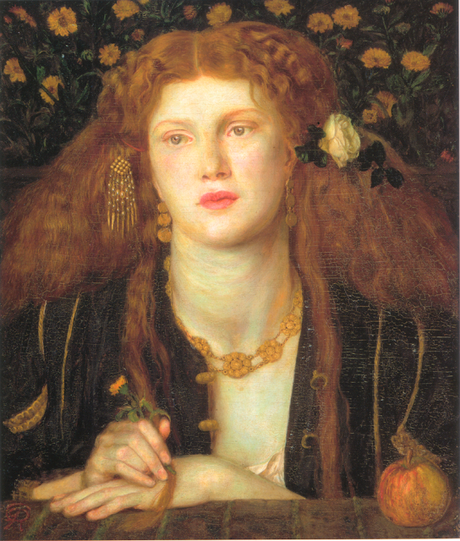
Bocca Baciata (1859) Dante Gabriel Rossetti
A beautiful, desirably, red-haired girl looks out of the canvas of her lover. Both paintings are warm and sensuous, Dolly and Fanny looking coy and knowing. Because of the title, Bocca Baciata seems to imply more about Fanny than Dolly's plain Head of a Girl but both paintings seem to add biography to their subjects rather than to their creators. That is doubly true of Dolly's portrait The Witch and arguably Fanny's outing as Lady Lilith...
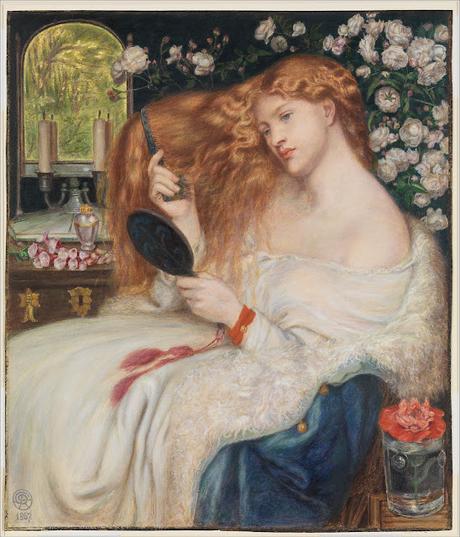
Lady Lilith (1867) Dante Gabriel Rossetti
Both women, at the end of their love affairs (allegedly) with the artists, pose for paintings as witches. Fanny and Rossetti were drawing to the end of their flurry of romance after the death of Elizabeth Siddal, and he would famously paint over her in the oil of this image, never again using Fanny as his main model. For many of Rossetti's friends and subsequent biographers, this image of Fanny, drawing her fingers through her hair, engrossed in her own reflection, summed up how deeply they hated her. She was unnatural, wicked, able to possess the artist and make him weak. Never did they acknowledge the cataclysmic mental health disaster that Rossetti went through. Somehow, Fanny and her evil powers were at the root of Rossetti's problems and would eventually be the death of him. Looking at it in those terms, I am almost inclined to forgive Fanny's critics as they were trying to explain something that had happened to their friend and brother without opening the box marked 'mental health'. They didn't know what to do with his titanic self-destruction so they blamed it on Fanny, after all Fanny survived. They make Rossetti's art about Fanny, and that is ridiculous. Back to Dolly...
There are some much fuller accounts of the years 1912-1914 (here for example) but it didn't take long for John and Dolly's relationship to become violent. This leads me to wondered why Jessie was already living with her parents in 1911, and it could be that she had left with her son before Dolly was even on the scene. While in Cornwall, Dolly fled from John who threatened her with a razor, and was found by Laura Knight hiding in her garden among sunflowers. An artist from Eastbourne, St. Clare O'Malley, reported how he had met Dolly who was sporting a black eye given to her by John in one of his jealous moods. John wrote to Dolly's parents promising to marry her, leaving out the part where he was already married until they found out and he promised to get a divorce. He didn't. Dolly turned 18 years old.
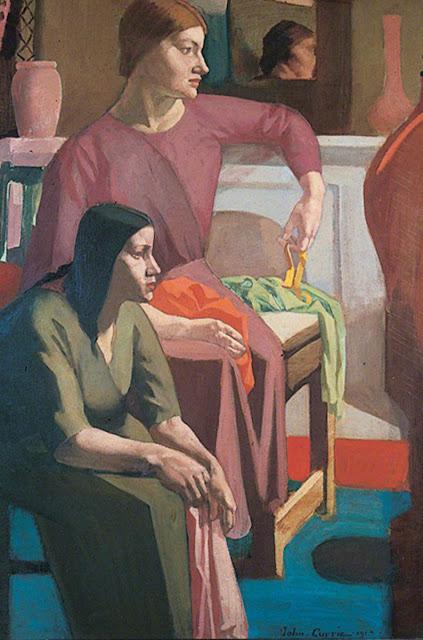
Seamstresses (Dolly and her cousin Mary) (1913) John Currie
Mark Gertler, tremendously in awe of John's talent, hooked up with the couple to make an odd threesome that traveled to Ostend together. Mark was closer to Dolly's age than John's and hero worshipped him. He had his own romantic problems, in love forever with Dora Carrington and arguably attracted to John, with not a little jealousy about Dolly. John Woodeson's 1972 biography of Gertler is not the place to go looking for a fair assessment of Dolly's life, but you certainly get an idea of what she was up against. Gertler became enmeshed in the couples dysfunctional, violent menage, and took John's side. He wrote to a friend "Currie is ill with rheumatism...so most of my evenings are spent with him in his rooms. Henry makes supper. I enjoy these quiet and peaceful evenings very much." Other friends of John and Gertler visited and passed judgment on Dolly - "the fair-haired girl was evidently not highly educated" remarked one, and patron of the arts, Edward Marsh gave his own verdict "There was no great harm in her but she was extremely vain and quite empty-headed - and jealous of his work."
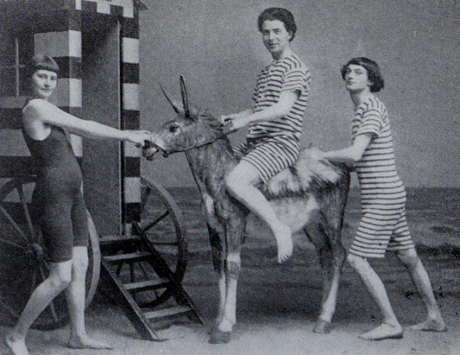
Dolly, John and Mark in Ostend (1912) from John Woodeson's biography
I have a special level of anger for when grown men feel entitled to pass judgment on teenage girls but really any privileged man who feels the need to comment negatively on a working class woman is going to receive my ire. Fanny Cornforth received heaps of criticism from Rossetti's circle, the majority of which was class-based in origin - the difference between Fanny, Elizabeth Siddal and Jane Morris was that Elizabeth and Jane allowed themselves to be elevated out of one class into another, by training, talent and keeping their mouths shut. Fanny did not lose the accent, nor have a talent for art,and she did not remain quiet and still. All of these things were commented on, even by William Allingham who, arguably, did not mean to criticize how she spoke or how she ran about the garden after the 'chicking', but it comes off as an educated man commenting on an uneducated woman. Luckily for Fanny, Rossetti was a cluster-mine of personal issues so when his mental health deteriorated most of his friends primarily blamed the death of Elizabeth rather than his relationship with Fanny. Had Elizabeth not died would Rossetti still have had the mental health he did? One thing Fanny was never blamed for was Rossetti's mental health - she was blamed for possibly enabling his addictions, but I suspect that to blame Fanny for Rossetti's depression would mean acknowledging it existed. Luckily for John Currie's friends and supporters, the blame for his mental health issues and violence could be placed squarely at the feet of a teenage girl.
I think the moment I really connected Fanny and Dolly in my mind was when I read Mark Gertler's comment - "It was bad enough when she kept quiet but now that she gives herself airs and talks, I can't stand it." This was said in response to Dolly attempting to talk about art with the men. The art that she appeared in. Others concentrated on how Dolly was destroying John with her womanly powers, as contemporary novelist Michael Sadleir wrote in his memoirs -
"Her lure for men was irresistible, and Currie was of course utterly enslaved to her physical attraction, a fact of which she was well aware. In her way she had a genuine love for him; but no glimmer of a notion that art could be of importance to anyone. Resenting his absorption in his work, determined herself to be his dominant preoccupation, she used her power to goad him from abject desire to baffled fury, and then, suddenly complaisant, to win him back again. This dangerous cruelty led to violent quarrels, and I suspect to blows."
At this point they are describing a woman of 20 who had lived with a violent man for 2 years. She would not live to see 21.
Dolly left John, and when her mother came looking for her, found her daughter with a razor-scrape across her throat, given to her by John of whom she was terrified. However, yet again she returned to him when he called for her. John had a new source of anger, a belief that Dolly had been spreading lies about him to his fellow artists, but I can find no reporting of what these untruths were. Dolly had told other artists that John beat her, possibly that is what he was referring to. Before the couple left for Brittany, for the good of John's health, he wrote to Edward Marsh, a patron and friend, apologising for his recent bad behavior - "I have behaved badly lately, but I am not well...Dolly is doing all that anyone could do to help. There is peace, but much is lost for the time."
The trip to Brittany remind me very much of Rossetti and Fanny's trip to Cumbria. It is a little relief in what is a god-awful situation. Both couples were happy for a while, with letters back from Brittany from John saying how they have danced and laughed, but soon Dolly left to return to London and Cornwall. They had met another English artist in Brittany who told her to her face that she did not appreciate art as she wasn't clever enough. That is no worse than everyone seems to have been saying behind her back but it was enough to drive her back, at least in John's report. It seems to me that Dolly had put up with far worse in the previous three years, so the words of a stranger seem a bit light to have sent her packing when it had been fear of John himself that had previously driven her away. Despite proclaiming himself content without Dolly, he followed her to Cornwall and threatened to throw her off a cliff and once more she fled. She stayed at Alderney Manor, near Poole in Dorset, with John's old friend Augustus John who didn't like her - "She was an attractive girl or used to be when I knew her first, but seemed to have deteriorated into a deceitful little bitch." Augustus John's portrait of her, The Woman in Green hangs in the South African National Gallery in Cape Town.
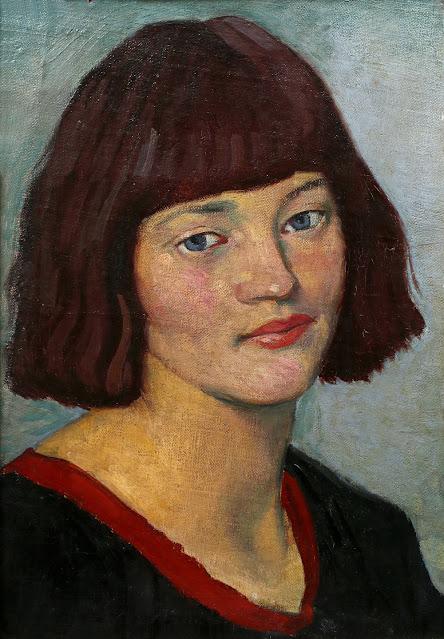
Dolly Henry (1913-4) William Strang
Dolly's last home was a flat in Paultons Square in Chelsea. She found work as a nude model but once more John found her, enraged that others were seeing her naked. On the 8th October 1914, John came to the flat early in the morning. When shots rang out, neighbours rushed to find Dolly in her nightdress, bleeding profusely on the landing and John, in the bedroom, with chest wounds. The defence of Dolly and John after their death was done by friends and family. Only Dolly's mother came forward to report the violence of the previous three years. John's wife appeared at the inquest, described as 'a slightly built lady of youthful appearance', and described her husband as having a 'passionate temperament' and told how she was trying to rebuild their marriage but he was too involved in his intrigue with Dolly. Michael Sadleir, a friend of John's, stated "Dolly drove Currie mad, and deprived the world of a genuine artist and a devoted worker." At the end of the entry on Paultons Square in the marvelous Murder Houses of London by Jan Bondeson, it is noted that because the murder happened not long after the First World War started, it was not given a great amount of publicity, so John's friends were able to buy up his work and it never dipped in price. If they had shown as much care for his behavior as they did for his artistic reputation then maybe he would have had a longer life and Dolly might not have spent her late teenage years being attacked before being murdered.
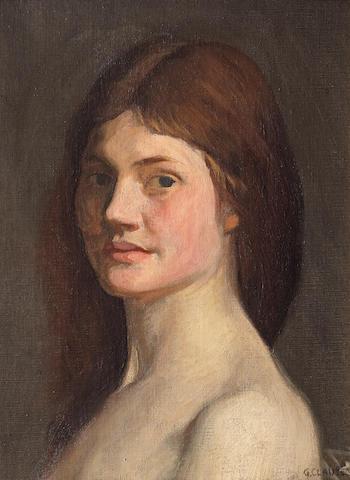
Head of a Woman (Dolly Henry) (1912-4) George Clausen
I get very angry about the way Fanny Cornforth is written about in the biographies of her contemporaries and later, because not one iota of space is given to what she dealt with, for which she had absolutely no experience or preparation. Fanny never let go of Rossetti, but possibly that's because the moment she took her eyes off him in 1872, he attempted suicide. She provided him with his drugs along with his paint as she just wanted him to continue living. It took around 8 years for Fanny to go from 'the kissed mouth' to 'the witch'; it took Dolly Henry barely 2. Rossetti's family shaped a narrative to disguise a reclusive man's mental illness, but John Currie's friends took his existing problems and placed them on the shoulders of a 17 year old girl. John Currie is an obscure artist now, kept from entirely slipping from view by interest in Dolly's murder, which is how I found him. Still the narrative that Dolly was a temptress who drove him mad is prolonged - for example, she is referred to as 'the volatile Dolly' in Bondeson's book, and the accounts of John's friends are repeated without question in their modern biographies. We need to be quicker to question these received 'facts' from the past and look at who is telling us what and why. Hopefully these days if a 27 year old man, a married man, hooked up with a 17 year old girl, we would know which way that power dynamic was flowing.
We need to do better because history, and life, is full of women like Fanny and Dolly and after the appalling things they had to put up with, they are overdue some respect.

